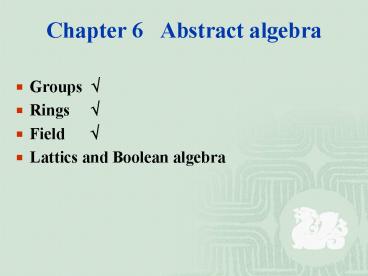Chapter 6 Abstract algebra PowerPoint PPT Presentation
1 / 22
Title: Chapter 6 Abstract algebra
1
Chapter 6 Abstract algebra
- Groups ?
- Rings ?
- Field ?
- Lattics and Boolean algebra
2
- 6.1 Operations on the set
- Definition 1An unary operation on a nonempty set
S is an everywhere function f from S into S A
binary operation on a nonempty set S is an
everywhere function f from SS into S A n-ary
operation on a nonempty set S is an everywhere
function f from Sn into S. - closed
3
- Associative law Let ? be a binary operation on a
set S. a?(b?c)(a?b)?c for ?a,b,c?S - Commutative law Let ? be a binary operation on a
set S. a?bb?a for ?a,b?S - Identity element Let ? be a binary operation on
a set S. An element e of S is an identity element
if a?ee?aa for all a ?S. - Theorem 6.1 If ? has an identity element, then
it is unique.
4
- Inverse element Let ? be a binary operation on a
set S with identity element e. Let a ?S. Then b
is an inverse of a if a?b b?a e. - Theorem 6.2 Let ? be a binary operation on a set
A with identity element e. If the operation is
Associative, then inverse element of a is unique
when a has its inverse
5
- Distributive laws Let ? and ? be two binary
operations on nonempty S. For ?a,b,c?S, - a?(b?c)(a?b)?(a?c), (b?c)?a(b?a)?(c?a)
Associative law commutative law Identity elements Inverse element
v v 0 -a for a
? v v 1 1/a for a?0
6
- Definition 2 An algebraic system is a nonempty
set S in which at least one or more operations
Q1,,Qk(k?1), are defined. We denoted by
SQ1,,Qk. - Z
- Z,
- N- is not an algebraic system
7
- Definition 3 Let S and T? are two
algebraic system with a binary operation. A
function ? from S to T is called a homomorphism
from S to T? if ?(ab)?(a)??(b) for
?a,b?S.
8
- Theorem 6.3 Let ? be a homomorphism from S to
T?. If ? is onto, then the following results
hold. - (1)If is Associative on S, then ? is also
Associative on T. - (2)If is commutative on S, then ? is also
commutation on T - (3)If there exist identity element e in
S,then ?(e) is identity element of T? - (4) Let e be identity element of S. If there
is the inverse element a-1 of a?S, then ?(a-1) is
the inverse element ?(a).
9
- Definition 4 Let ? be a homomorphism from S
to T?. ? is called an isomorphism if ? is also
one-to-one correspondence. We say that two
algebraic systems S and T? are
isomorphism, if there exists an isomorphic
function. We denoted by S?T?(S?T)
10
6.2 Semigroups,monoids and groups
- 6.2.1 Semigroups, monoids
- Definition 5 A semigroup S? is a nonempty set
together with a binary operation ? satisfying
associative law. - Definition 6 A monoid is a semigroup S ?
that has an identity.
11
- Let P be the set of all nonnegative real numbers.
Define on P by - ab(ab)/(1a ? b)
- ProvePis a monoid.
12
6.2.2 Groups
- Definition 7 A group S ? is a monoid, and
there exists inverse element for ?a?S. - (1)for ?a,b,c?S,a ?(b ? c)(a ? b) ? c
- (2)?e?S,for ?a?S,a ? ee ? aa
- (3)for ?a?S, ?a-1?S, a ? a-1a-1 ? ae
13
- R-0,? is a group
- R,? is a monoid, but is not a group
- R-0,?, for ?a,b?R-0,a?bb?a
- Abelian (or commutative) group
- Definition 8 We say that a group G?is an
Abelian (or commutative) group if a?bb?a for
?a,b?G. - R-0,?,Z,R,C are Abelian (or
commutative) group . - Example Let G ? be a group with identity e.
If x ? xe for ?x?G, then G ? is an Abelian
group.
14
Example Let G1,-1,i,-i.
15
- G1,-1,i,-i, finite group
- R-0,?,Z,R,C,infinite group
- Gn is called an order of the group G
- Let G (x y) x,y?R with x ?0 , and consider
the binary operation ? introduced by (x, y) ?
(z,w) (xz, xw y) for (x, y), (z, w) ?G. - Prove that (G ?) is a group.
- Is (G?) an Abelian group?
16
- R-0,? , R
- abcdef(ab)cd(ef),
- a?b?c?d?e?f?(a?b)?c?d?(e?f)?,
- Theorem 6.4 If a1,,an(n?3), are arbitrary
elements of a semigroup, then all products of the
elements a1,,an that can be formed by inserting
meaningful parentheses arbitrarily are equal.
17
- a1 ? a2 ? ? an
If aiaja(i,j1,,n), then a1 ? a2 ? ?
anan? na
18
- Theorem 6.5 Let G? be a group and let
ai?G(i1,n). Then - (a1??an)-1an-1??a1-1
19
- Theorem 6.6 Let G? be a group and let a and b
be elements of G. Then - (1)acbc, implies that ab(right cancellation
property)? - (2)cacb, implies that ab?(left cancellation
property) - Sa1,,an, alai?alaj(i?j),
- Thus there can be no repeats in any row or column
20
- Theorem 6.7 Let G? be a group and let a, b,
and c be elements of G. Then - (1)The equation a?xb has an unique solution in
G. - (2)The equation y?ab has an unique solution in G.
21
- Let G? be a group. We define a0e,
- a-k(a-1)k, akaak-1(k1)
- Theorem 6.8 Let G? be a group and a ?G, m,n
?Z. Then - (1)amanamn
- (2)(am)namn
- aaama,
- mana(mn)a
- n(ma)(nm)a
22
- Next Permutation groups
- Exercise P348 (Sixth) OR p333(Fifth)
9,10,11,18,19,22,23, 24 - P355 (Sixth) OR P340(Fifth) 57,13,14,1922
- P371 (Sixth) OR P357(Fifth) 1,2,6-9,15, 20
- Prove Theorem 6.3 (2)(4)

